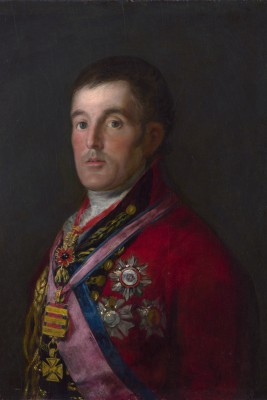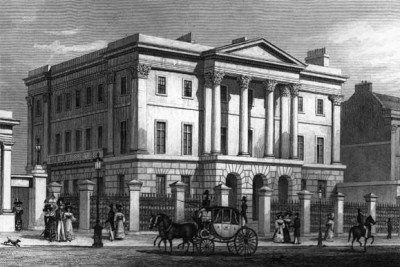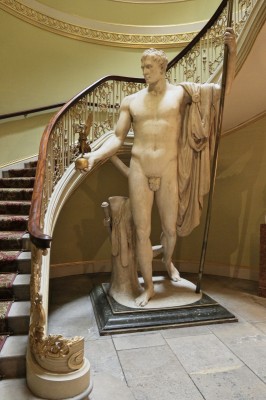Wellington and Apsley House
(vero;2022-Oct-13)
 Apsley House is the London town house of the Dukes of Wellington. It is a Georgian mansion built between 1771 and 1777 by the 2nd Earl of Bathurst (known as Lord Apsley), and was the first house to be built north of the famous Picadilly, earning it the nickname "Number 1, London".
Apsley House is the London town house of the Dukes of Wellington. It is a Georgian mansion built between 1771 and 1777 by the 2nd Earl of Bathurst (known as Lord Apsley), and was the first house to be built north of the famous Picadilly, earning it the nickname "Number 1, London".  It is now located at a most fashionable address: Hyde Park Corner. The house changed ownership in 1807 when Richard, Marquess of Wellesley bought it from the 3rd Earl and furnished it after a complete makeover; but alas… the Marquess had poorly calculated and went bankrupt.
It is now located at a most fashionable address: Hyde Park Corner. The house changed ownership in 1807 when Richard, Marquess of Wellesley bought it from the 3rd Earl and furnished it after a complete makeover; but alas… the Marquess had poorly calculated and went bankrupt.
And it was his younger brother Arthur who bailed him out by buying the house… But who was Arthur to have so much money? Well… no other than the one who brought Napoléon down on his knees in Waterloo!
Arthur Wellesley (1769-1852), a seasoned military man, was noticed during his service in India, and had become famous following his role as a general during the Iberian campaign of the Napoleonic wars (1808-1814). He was promoted to the rank of Field Marshal after having led the allied forces to victory against the armies of the French Empire at the Battle of Vitoria in 1813 and he was the one who ejected Joseph Bonaparte from the throne of Spain. He fought the French relentless and after Napoléon's exile to the island of Elba in 1814 was ennobled and received the title of Duke of Wellington. The rest is history: he commanded the allied army during the Hundred Days after Napoléon returned from Elba and with the German Blücher defeated the French Emperor in Waterloo. Wellington's military achievements are exemplary: he participated in sixty battles during his military career.
After his resounding victory in Waterloo, the Parliament granted £700,000 to the new national hero so that he could build himself a new "Waterloo palace". This ennobling and this generous financial mane reminded us strongly of what had happened to John Churchill, Duke of Marlborough, after he defeated Louis XIV in 1704 (read our blog article to know more). It is the same logic: the grateful nation rewarding largely its hero followed by the birth of an influential lineage, this time the one of the Wellingtons (we count nowadays the 9th of the name, still involved in politics and an hereditary lord).
However, instead of embarking on the construction of a new palace as John Churchill did with Blenheim, Arthur decided to submit an anonymous offer to buy Apsley House from his brother. He paid £40,000, 5 % of his endowment, keeping the rest to enlarge Apsley House and make it a home befitting his new status, the ideal mean to establish himself in the highest ranks of the society of the time; and it worked perfectly. He was involved in politics, was a deputy, occupied the post of Prime Minister in 1828, sat in the House of the Lords and was commander-in-chief of the British army until his death in Walmer Castle, Kent.
But back to Apsley House: the upper floor is still occupied by the Wellingtons (the 9th Duke resides when he is in session at the Chamber of Lords among others), but the ground floor and the 1st floor have been transformed into a museum managed by English Heritage. There are no furniture in the rooms open to the public but they contain a multitude of works of art.  A large part of the collection comes from Wellesley's Iberian campaign: Napoléon is well known for having plundered the works of art from the countries he occupied. And the same is true for the British. When Wellesley evicted Joseph Bonaparte, he made a point of recovering all the works of art that the French were trying to take out of the country in their flight to France. This is why the collection contains so many works by Velásquez, Murillo, Goya and Riberá; Wellington offered to restore the Spanish paintings to the King of Spain Ferdinand VI but it was refused and so they still adorn the walls of Apsley House. The Duke later enlarged his collection by acquiring works of Brueghel, Maes, Jan Steen, Titien, Rubens, Van Dyck or Caravaggio to name just a few; the works of art presented nowadays in London are worthy of the greatest museums.
A large part of the collection comes from Wellesley's Iberian campaign: Napoléon is well known for having plundered the works of art from the countries he occupied. And the same is true for the British. When Wellesley evicted Joseph Bonaparte, he made a point of recovering all the works of art that the French were trying to take out of the country in their flight to France. This is why the collection contains so many works by Velásquez, Murillo, Goya and Riberá; Wellington offered to restore the Spanish paintings to the King of Spain Ferdinand VI but it was refused and so they still adorn the walls of Apsley House. The Duke later enlarged his collection by acquiring works of Brueghel, Maes, Jan Steen, Titien, Rubens, Van Dyck or Caravaggio to name just a few; the works of art presented nowadays in London are worthy of the greatest museums.
And then there is the rest.… Again, there are similarities with Blenheim. Just as Blenheim is full of objects relating to Louis XIV, Apsley House is full of Napoleonic and Waterloo memorabilia. I would divide them into two categories:
First category: Waterloo
- Paintings, sculptures, goldware and silverware (many snuffboxes) or porcelain tableware offered to Wellington by the grateful European nations. Impressive but not always tasteful. Imagine endless china sets (counting a minimum of 100 pieces): the one of the King of Prussia in Berlin porcelain, the one of the King of Saxony in Meissen porcelain and others offered by his former companions-in-arms in India… But what to do with so many sets? I imagine Wellington, jaded, receiving yet another service… There is also one of Sèvres porcelain offered by Napoléon to Joséphine as a divorce gift and whose theme is landscapes of Egypt, showing rural scenes and the most imposing monuments of the country; Joséphine rejected it and it was Louis XVIII who elegantly got rid of it by giving it as thanks to Wellington for his contribution to the fall of the tyran and the liberation of France.
- But some were not only some simple china sets: several came with fairly lavish centrepieces to be displayed in the middle of banqueting tables. Thus, Joséphine's service came with a 3D representation of various Egyptian temples. Or what about the one which came with the china set presented by the King of Portugal, a huge extravaganza that was enthroned in the middle of the table during the annual banquets given by the Duke in memory of his victory of Waterloo? The following articles about the Waterloo banquets make a very interesting read, they come in two parts: part one about the organisation and attendance and part two dealing more with the banqueting gallery, the china and paintings in the room.
- There are also many portraits representing the allied victors of the time: the tsar of Russia and assorted kings and princes of the time adorning the banquet hall, or portraits of the British soldiers engaged in his several campaigns hanging in other rooms.
Second category: Napoléon
- They are portraits, sculptures, many of these works having been "given" by Louis XVIII who was very happy to get rid of them. I liked a portrait of a young Napoléon and almost burst out laughing when I saw the monumental statue representing him as the God Mars. Napoléon supposedly rejected it under the pretext that it was too athletic (!) So, the statue was relegated to an obscure place before being recovered by Wellington: weighing 3 tons, the Duke had to consolidate the floor of the room where he wanted to display it to bear its weight.
Click on this link for some highlights of the Wellington's Collection.
Want to read more? Go back to Eltham the Courtauld's Way or go on to Blenheim Palace: the English answer to Versailles? or go up to Blog
$ updated from: Blog.htxt Mon 28 Apr 2025 14:55:35 trvl2 — Copyright © 2025 Vero and Thomas Lauer unless otherwise stated | All rights reserved $



